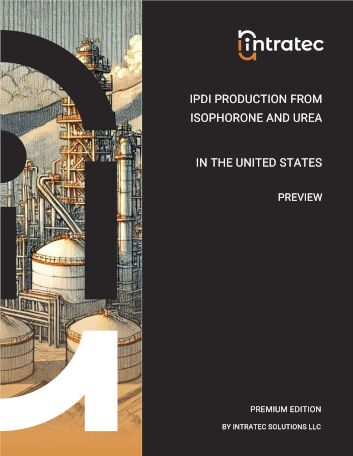Commodity Production Costs Report
IPDI Production from Isophorone and Urea
IPDI Plant Capital & Operating Cost Analysis | United States | Q3 2025
This report presents the economics of Isophorone Diisocyanate (IPDI) production from isophorone and urea. The process examined is a typical non-phosgene technology. In this process, isophorone diamine (IPDA) is initially obtained from isophorone. Then, IPDA reacts with urea and butanol generating a carbamate intermediate. Then, the carbamate is thermally cracked producing IPDI.
The report provides a comprehensive study of IPDI production and related IPDI production cost, covering three key aspects: a complete description of the IPDI production process examined; an in-depth analysis of the related IPDI plant capital cost (Capex); and an evaluation of the respective IPDI plant operating costs (Opex).
The IPDI production process description includes a block flow diagram (BFD), an overview of the industrial site installations, detailing both the process unit and the necessary infrastructure, process consumption figures and comprehensive process flow diagrams (PFD). The IPDI plant capital cost analysis breaks down the Capex by plant cost (i.e., ISBL, OSBL and Contingency); owner's cost; working capital; and costs incurred during industrial plant commissioning and start-up. The IPDI plant operating costs analysis covers operating expenses, including variable costs like raw materials and utilities, and fixed costs such as maintenance, labor, and depreciation.

Product
IPDI. IPDI (a.k.a. Isophorone Diisocyanate) is one of the main aliphatic diisocyanates, being widely employed in polyurethanes production for coating applications. It is highly reactive, so it can undergo several addition reactions across the CN double bond in such a way that a myriad of commercial products can be obtained from reactions with alcohols, carboxylic acids, and amines.
Raw Materials
Urea. Urea is a nitrogen-rich fertilizer essential for modern agriculture. It is also used in the production of plastics, resins, and pharmaceuticals. Urea is synthesized from ammonia and carbon dioxide and is typically stored in solid granules or liquid form. Its widespread use in farming helps boost crop yields worldwide.
Isophorone. Isophorone (3,5,5-trimethyl-2-cyclohexen-1-one) is derived from the trimerization of acetone. More specifically, it is produced by the aldolization of acetone under alkaline conditions. This cyclic unsaturated ketone serves as solvent for a range of polymers, resins, fats, oils and agrochemicals. Although it has traditionally been used as a low volatility solvent, it is also an important industrial building block, as a raw material to produce isophorone diisocyanate (IPDI) for the production of light-stable polyurethane.
Report in PDF Format
Download & Explore Anytime
Access in Various Devices
Print & Read Comfortably
Share With Co-workers
Up-to-date Report
Professional report based on Q3 2025 economic data, ensuring timely evaluations.
Multiple Use Cases
Ideal for investment screening, feasibility studies, cost estimates, and research planning.
Proven Methodology
Developed using a consistent methodology honed over a decade, ensuring reliable cost analyses.
Report Editions
Content Highlights
Plant Capital Cost Summary
Summary outlining the capital cost required for building the IPDI production plant examined.
Plant Capital Cost Details
Detailing of fixed capital (ISBL, OSBL & Owner’s Cost), working capital and additional capital requirements.
Plant Cost Breakdowns
Breakdown of IPDI process unit (ISBL) costs and infrastructure (OSBL) costs; plant cost breakdown per discipline.
Operating Costs Summary
Summary presenting the operating variable costs and the total operating cost of the IPDI production plant studied.
Operating Cost Details
Detailing of utilities costs, operating fixed costs and depreciation.
Plant Capacity Assessment
Comparative analysis of capital investment and operating costs for different IPDI plant capacities.
Production Process Information
Block Flow Diagram, descriptions of process unit (ISBL) and site infrastructure (OSBL).
Process Consumptions
Raw materials and utilities consumption figures, by-products credits, labor requirements
Process Diagrams
Process flow diagrams (PFD), equipment list and industrial site configuration
Other IPDI Production Cost Reports

IPDI Production from Isophorone and Chlorine
This report presents the economics of Isophorone Diisocyanate (IPDI) from isophorone and chlorine in the United States. In the process examined, isophorone is reacted with hydrogen cyanide, generating IPN. IPN obtained is then reacted with ammonia to form IPNI, which is hydrogenated with more ammonia to yield IPDA. Finally, IPDA reacts with phosgene to produce IPDI. The phosgene used is generated from chlorine and carbon monoxide.
Details: 15 kta United States-based plant | Q3 2025 | 107 pages | Issue A | From $1,199 USD
Bundle & Save
Purchase multiple IPDI Production Cost reports and enjoy tiered discounts
up to 10% off!
Could Not Find the Report You Need?
Obtain a Bespoke Report
Get a report targeting the process in which you are interested
See Offer Details
Understand Bespoke Reports and how you can easily order them
Check Editions & Pricing
Complete a brief form and see a quotation for your Bespoke Report
Other Related Production Cost Reports

Granulated Urea Production from Ammonia (Self-Stripping Process)
This study approaches the economics of Granulated Urea production from ammonia and carbon dioxide in the United States through Saipem's (formerly Snamprogetti) ammonia stripping technology. In this process, ammonia and carbon dioxide are converted to Urea via ammonium carbamate intermediate. The non-converted carbamate is stripped from the Urea solution by excess ammonia and decomposed back to ammonia and carbon dioxide, which are recycled to the Urea synthesis.
Details: 1300 kta United States-based plant | Q3 2025 | 107 pages | Issue C | From $799 USD

Granulated Urea Production from Natural Gas (Chemical Looping Process)
This study approaches the economics of Granulated Urea manufacturing from natural gas in an industrial complex with a novel plant configuration, where a unit that produces ammonia from natural gas using chemical looping reactors is integrated to a Urea production unit. The economic analysis provided assumes a complex located in the USA.
Details: 1300 kta United States-based plant | Q3 2025 | 107 pages | Issue G | From $1,199 USD
+800 Reports Developed, Targeting +250 Commodities
Vast Report Library
858 independent and up-to-date reports examining embryonic and established production processes.
Free Sample Reports
Quickly understand the structure and depth of content of our professional reports.

